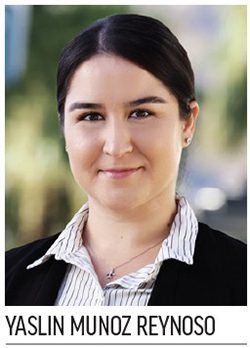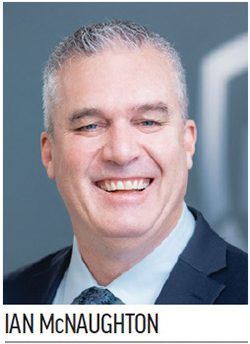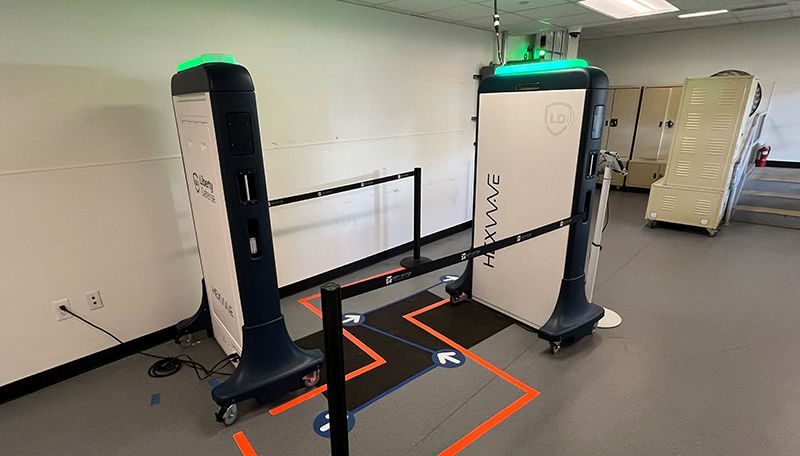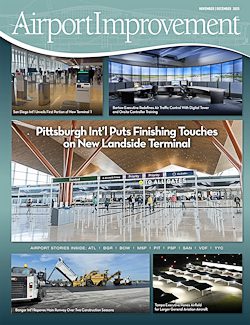Palm Springs International Airport (PSP) in Southern California is raising the bar for employee screening with early adoption of an AI-driven system to improve detection of insider threats.
The airport installed its new contactless walk-through screening portal earlier this year, becoming the fourth airport to implement the HEXWAVE system in the U.S. Like the others, PSP is ahead of a new TSA mandate that requires all U.S. airports to implement programs by April 1, 2026 to screen employees with access to secure areas.
“PSP saw an opportunity to get ahead of the curve,” explains Airport Security Manager Yaslin Munoz Reynoso. “HEXWAVE fits perfectly with our goal of keeping the airport safe while staying innovative. For us, it’s not just about checking a box for compliance. It is about raising the bar to not only meet but exceed security standards.”
| facts&figures
Project: Employee Screening Location: Palm Springs Int’l Airport, in CA Technologies: Active millimeter-wave technology, advanced 3D imaging & artificial intelligence Equipment Format: Contactless walk-through portal Employees Affected: Those accessing secure areas System: HEXWAVE, from Liberty Defense Technologies Inc. Total Project Cost: $172,000 Funding: Enterprise funds generated by airport Timeline: Request for proposals issued in Sept. 2024; system installed in June 2025 & went live in July 2025 Equipment Consultant & Staffing: Veterans High Risk Security Solutions Federal Mandate: TSA-NA-23-02 requires U.S. airports to implement screening programs for employees with access to secure areas by April 1, 2026 System Speed: About 6 seconds to screen 1 person (including time to pass through, receive results & exit) Throughput: Items Targeted: Metallic & non-metallic weapons & prohibited items; powders; liquids; 3D printed weapons; etc. Key Benefit: Identifying & deterring insider threats |
The move also solidifies PSP’s position as a leader in aviation security, she adds.
“While many airports will be racing to meet the new federal mandate in time, we are already there,” says Reynoso. “By putting the system in place now, we are leading the way—not waiting for deadlines but adding an extra layer of security to protect passengers and airport employees now.”
Total project cost for the new system was $172,000, paid for with enterprise funds generated by the airport.
Targeting Insider Threats
In 2023, TSA officials acknowledged the need to enhance screening for aviation workers with access to secure or sterile airport areas. Its associated mandate, TSA-NA-23-02, includes an April 1, 2026, deadline for U.S. airports to implement screening programs that help detect and deter insider threats.
Officials at Liberty Defense, the company that designed, engineered and manufactures the HEXWAVE system, say the mandate was long overdue. “Most airports are checking badges to make sure workers are authorized to enter secure areas, but they are not checking for threats on their bodies or among their personal property,” explains Ian McNaughton, senior director of business development at Liberty Defense. “Some airports visually screen employees’ bags, but that’s not always very effective.”
To its credit, PSP was using metal detectors to screen employees before TSA announced its forthcoming requirements.
The new federal mandate calls for a non-discriminatory, physical and technology-based process to search aviation workers, aiming to detect and prevent unauthorized weapons, explosives and incendiaries from entering secure areas. More specifically, it requires airports to visually verify employee IDs and screen workers, their coats/jackets and accessible personal property, with a focus on detecting metallic and non-metallic threats.
“Insider threats are one of the toughest challenges in aviation security,” Reynoso stresses. “Traditional metal detectors can’t catch everything. By adding HEXWAVE, we establish the expectation that everyone entering secure areas will be regularly screened.”
To meet the new mandate’s requirements, PSP sought a combination of technology and human-based solutions. In September 2024, it issued a request for proposals from qualified firms to provide worker screening services at the airport. The selected firm would also be responsible for procuring the associated equipment. For guidance, the airport detailed its operational needs and provided a list of equipment that meets TSA-NA-23-02 requirements.
In late January 2024, the airport sent a contract to Veterans High Risk Security Solutions, a security firm based in Rancho Mirage, CA, to provide worker screening services and bring HEXWAVE to PSP.
The new screening technology was delivered on March 28—later than originally scheduled, per the airport’s preference.
“HEXWAVE offered a whole new level of detection,” Reynoso reports. “The system is programmed to go beyond knives and guns, catching powders, liquids and even 3D printed weapons that won’t show up on a metal detector.”
 The automated system also keeps up with evolving threats, she adds. “HEXWAVE is built with the capability to support future software upgrades, allowing it to adapt to emerging threats or changing security needs.”
The automated system also keeps up with evolving threats, she adds. “HEXWAVE is built with the capability to support future software upgrades, allowing it to adapt to emerging threats or changing security needs.”
Walk-Through Technology
According to a recent economic impact study, PSP supported nearly 18,400 jobs last fiscal year, underscoring the need for a robust employee screening program. Moving forward, the pending TSA mandate will require continuous, randomized screening based on the number of airport access points and employees at each location.
“The screening needs to be random so employees don’t know whether they will be screened from day to day,” McNaughton explains.
Because PSP has only one access point for aviation workers, it operates one HEXWAVE unit stationed in a fixed location. The equipment, however, has rotating casters and side handles so personnel can move it to screen employees at different locations throughout the day. That is the routine at Manchester-Boston Regional Airport.
“Moving the system doesn’t require any recalibration,” McNaughton advises. “They just power it off, unplug the cords, plug it back in and start screening.”
The HEXWAVE system combines active millimeter-wave technology, advanced 3D imaging, and artificial intelligence to detect potential threats. The millimeter waves are safe and do not penetrate the skin, producing no ionizing radiation, notes McNaughton. The waves transmit outward, pass through clothing, reflect off the body, and return to a HEXWAVE receiver, which generates a holographic image for the detection algorithm to analyze.
The walk-through system has a throughput rate of up to 700 people per hour under ideal circumstances. While it meets requirements of the Americans With Disabilities Act, PSP also offers alternate forms of screening that are vetted and approved by TSA to ensure compliance with the new mandate.
 “Screening is faster because it happens as the person is in motion,” McNaughton explains. “As they walk through, the millimeter wave can detect both metallic and nonmetallic threats. It can even identify 3D-printed guns, which metal detectors—even enhanced metal detectors—cannot detect.”
“Screening is faster because it happens as the person is in motion,” McNaughton explains. “As they walk through, the millimeter wave can detect both metallic and nonmetallic threats. It can even identify 3D-printed guns, which metal detectors—even enhanced metal detectors—cannot detect.”
From Reynoso’s perspective, the lack of effort required by employees is a big plus. “It’s a walk-through system. There’s no stopping or emptying your pockets,” she highlights. “It picks up threats almost instantly, so workers get screened without losing time. That’s a big win for safety and operations.”
The number of workers passing through the new system fluctuates from day-to-day—adding to the random and unpredictable nature of PSP’s screening program. “The goal of our screening is for it to be random and unpredictable. However, the volume of screening varies due to multiple factors, including screening times, flight loads and daily workforce changes. Ultimately, our goal is to achieve 100% screening of all aviation workers every day,” shares Reynoso.
McNaughton emphasizes that weapons are detected in near-real time, with equipment operators alerted about suspected threats within 0.2 seconds.
The system addresses privacy concerns by only displaying the location of a potential threat on an avatar figure. Reynoso also points out that the system doesn’t save images; they are automatically deleted when no longer needed.
“When the system highlights a specific area that could be a threat, a third-party screening officer or airport employee can then ask the individual to remove any items in that area and walk through again,” McNaughton explains. “The advantage is that no clothing needs to be removed; just the contents of their pockets.”
Overall, the screening process takes about six seconds from start to finish, including walking through, receiving results and moving on. “That’s with no alarms,” McNaughton specifies.
Even with its next-gen system in place, PSP still uses walk-through metal detectors to accommodate employees who are hesitant about the new HEXWAVE unit.
“It’s common for airports to use a mix of security technology,” notes McNaughton. “In the future, we’ll probably see a people screener, an X-ray machine and trace detection for the identification of explosives at these checkpoints.”
Installation
The airport chose to locate its new screening system at the main employee entrance, a central spot to minimize delays. Once employees pass through the portal, they cannot return to the secure area without being screened again.
“Installation required close collaboration among Liberty Defense, Veterans High Risk Security Solutions and the airport’s Security, Maintenance and IT departments to ensure a smooth, streamlined deployment,” Reynoso says.
The HEXWAVE team handled installation, calibration and training.
No building modifications were necessary because PSP had created an aviation worker screening room during its recent ticketing wing expansion.
The two main installation requirements are power outlets and space. Each 140-pound unit measures about 73 inches tall, 44 inches wide, 9 inches deep and requires two power outlets.
“Most airports don’t want to spend extra money on building changes because this is an unfunded TSA mandate,” McNaughton notes. “They want to minimize capital expenses. Many airports have pushed back since it comes out of their own budgets. But ICAO (International Civil Aviation Organization) is mandating members toward 100% aviation worker screening, and it’s been implemented globally.”
Reynoso reports that installation at PSP was a breeze, but there was a learning curve to navigate afterward. “As with any new equipment, a period of adjustment is necessary to become fully acquainted and comfortable with the system, for both the operator and the end user,” she remarks.
Looking ahead, the airport plans to expand use of the system to more checkpoints as PSP grows.
Lessons for Other Airports
Reynoso recommends careful planning when adding a HEXWAVE system.
“Start by developing a clear, well-defined scope of work. Assess operational needs, ensure adequate space and allocate sufficient time to properly introduce the system to screening personnel and employees,” she advises. “Strong collaboration across departments and comprehensive training for screening professionals are essential to support a smooth and effective transition.”
She hopes that sharing details about PSP’s early adoption will help other airports as they work to meet the looming 2026 TSA deadline.



